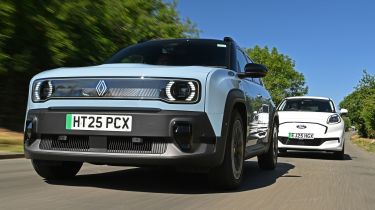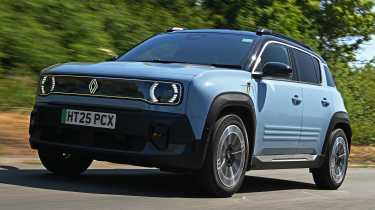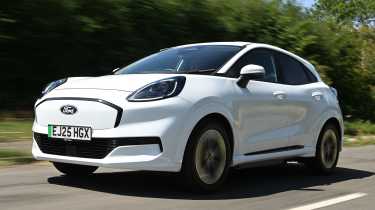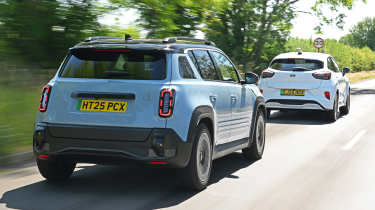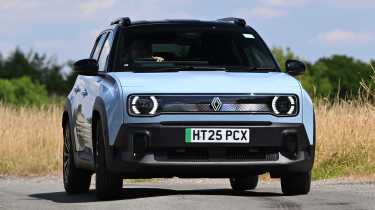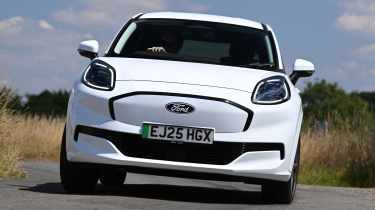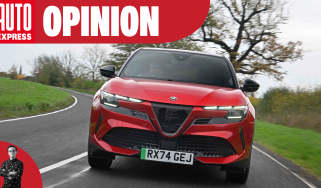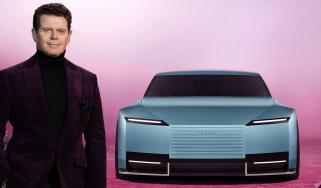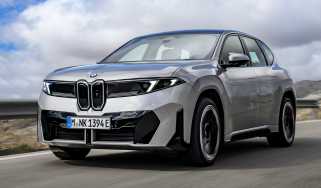Renault 4 vs Ford Puma Gen-E: can French fancy declaw its EV rival?
We pitch the new Renault 4 EV against one of its chief small SUV rivals, Ford’s Puma Gen-E
There are two distinct routes that car makers can take to electrify their model line-ups. Depending on time frames and cost, some companies have been able to create bespoke electric car platforms, with scalable tech that can be adjusted to suit different requirements. That’s the path Renault has chosen with the R4, a car that follows hot on the heels of the numerically larger, but physically smaller, Renault 5 supermini.
As the Captur is to the Clio, so the Renault 4 is to the 5, with its retro-inspired design adorning a larger SUV-style body that offers more space than the supermini’s, but also features virtually identical technology on board.
The second option is to electrify an existing combustion-engined platform. While Ford offers dedicated EV tech in its line-up, it has gone down this route with the new Ford Puma Gen-E, which is based on the firm’s best seller, but without a trace of combustion power.
In both instances, these small SUVs aim to deliver a usable range and decent everyday practicality in a package that is priced at a comparable point to the petrol-engined alternatives. But which one delivers the best overall experience?
Renault 4
| Model: | Renault 4 E-Tech Techno |
| Price: | £28,995 |
| Powertrain: | 52kWh battery, 1x electric motor, 148bhp |
| 0-62mph: | 8.2 seconds |
| Test efficiency: | 4.0 miles/kWh |
| Official range: | 245 miles |
| Annual VED: | £195 |
Since the Renault 5 took design inspiration from the company’s back catalogue, the French firm couldn’t really do anything else with the SUV variant. The 4 is longer than the 5 hatchback overall and also has a longer wheelbase, so it’s better suited to family duties. Power comes from the larger 52kWh battery found in the supermini, while prices are competitive: they start from £27,000 for Evolution trim, while Techno (our pick) costs £29,000 and the top-spec Iconic model in our pictures is £31,000.
Tester's notes
The Renault 4 draws design inspiration from the firm’s back catalogue, but the E-Tech model is light years ahead in terms of quality. While the dash layout is identical to the R5’s, the separate climate controls and stubby infotainment stalk positioned lower down on the steering column will be familiar to anyone who has driven a modern Renault. It does mean the right side of the steering wheel is a little busy, with the infotainment control, the wiper stalk and drive selector all closely packed together.
Ford Puma Gen-E
| Model: | Ford Puma Gen-E Select |
| Price: | £29,995 |
| Powertrain: | 43kWh battery, 1x electric motor, 166bhp |
| 0-62mph: | 0-62mph: 8.0 seconds |
| Test efficiency: | 4.7 miles/kWh |
| Official range: | 234 miles |
| Annual VED: | £195 |
While the petrol Puma offers a few engine choices and trim options, the Gen-E line-up has been kept simple. There’s just one powertrain, comprising a 53kWh battery (43kWh of which is usable) and a 166bhp electric motor that sends power to the front wheels. There are only two trim options, with the Select model coming
in at five pounds under £30,000 and the higher-spec Premium costing £2,000 extra. However, even the base model tested here comes with a generous list of kit.
Tester's notes
It’s one thing testing electric cars in the summer months, but in winter, colder temperatures will take a chunk out of the Puma’s driving range. Ford mitigates against this by fitting the Gen-E with a heat pump as standard, which is surprising because it’s an option on the pricier Explorer and Capri. The Puma also comes with Ford’s excellent Quickclear windscreen, but a heated steering wheel and front seats are part of a £350 option pack. Most rival EVs feature these as standard as a quick way to get warm.
Used - available now

2018 Skoda
Superb Estate
121,210 milesAutomaticDiesel2.0L
Cash £9,295
2018 MINI
3-Door Hatch
62,398 milesManualPetrol2.0L
Cash £7,995
2018 Peugeot
208
64,000 milesManualDiesel1.5L
Cash £6,480
2024 BMW
iX3
29,247 milesAutomaticElectric
Cash £29,276Did you know you can sell your car through Auto Express? We’ll help you get a great price and find a great deal on a new car, too.
Head-to-head
On the road
The Puma is one of the best-handling small SUVs in petrol guise, and despite being around 200kg heavier, the Gen-E retains that car’s fun character. In fact, the weight of the battery means it rides a bit more smoothly. It’s not as comfortable as the Renault 4, though, which offers a soft edge that promotes cruising comfort. In terms of acceleration, there’s not much in it, but the Puma feels punchier off the line.
Tech highlights
The Renault’s cabin is carried over wholesale from the R5, so you get a modern-looking layout with plenty of tech and user-friendly details. It’s a similar story with the Puma Gen-E, which features the same 12-inch touchscreen display as the petrol version, although as with that car, the screen’s size and position mean that the steering wheel can end up obscuring some of the information nearest the driver.
Price and running
Both cars are great value for EVs, and it’s worth noting that the electric Puma costs less than some of the highest-spec versions of the petrol model. Efficiency was strong for both cars, but the Renault’s figure of 4.0mi/kWh was eclipsed by the Ford’s, at 4.7mi/kWh. It means that while the Puma has nearly 10kWh less of usable capacity, its actual driving range is similar to that of the Renault’s, at just over 200 miles on test.
Practicality
The Renault 4 is shorter than the Puma but has a longer wheelbase, while a wider cabin and taller roof mean it feels more spacious for back-seat passengers. A very low load lip is another benefit that the Renault carries over the Ford, but the Gen-E has the greater overall volume courtesy of its Gigabox, which is bigger than the petrol Puma’s Megabox. Surprisingly, the Ford also has under-bonnet storage – the Renault doesn’t.
Safety
There are four-star Euro NCAP safety ratings for both cars here, with the Puma’s score being carried over from the petrol version. On the R4, kit such as a door-opening warning and rear pedestrian-crossing alert when reversing are available solely on the top-spec version. The Puma only offers the latter, plus front parking sensors, adaptive cruise and blind-spot detection as part of a £950 Advanced Driver Assistance Pack.
Ownership
Warranty coverage is only average for the Puma, with a typical three-year/60,000-mile plan offered, although it can be extended at extra cost. For the Renault 4 there is four years and 100,000 miles of cover. As for servicing, intervals are every 24 months for both cars, although the Renault has an 18,000-mile limit. Ford includes the first five years of servicing in the price of the Puma to help reduce costs even further.
Verdict
Winner: Renault 4
What you’re looking at here are possibly the two best small electric SUVs currently on sale, and choosing a winner is a tough call. However, we think that the Renault 4 has an advantage over the Ford, courtesy of its extra passenger space and slightly longer range.
The striking retro-inspired looks help the R4 to stand out from the crowd, while the user-friendly touchscreen tech is easy to live with and the boot offers a useful amount of space. We’d like to see faster DC charging, and rear space is still a little compromised, but overall the Renault 4 is a great small electric SUV.
Runner-up: Ford Puma Gen-E
Fans of the petrol Puma won’t be disappointed with the electrified version. The battery’s extra weight hasn’t impacted the handling too severely, and has actually boosted comfort a little, while no compromises have been made in terms of passenger or boot space. That does mean the back seats are still a little on the small side, but if you regularly travel two-up, then this won’t be an issue.
Most impressive is the efficiency that the Puma returned on test, which made up for the relatively small battery. Add in competitive pricing, and the Gen-E deserves to sell well.
Prices and specs
| Renault 4 | Ford Puma Gen-E | |
| Our choice | Renault 4 Techno | Ford Puma Gen-E Select |
| Price of our choice/price as tested | £28,995/£30,995 | £29,995/£29,995 |
| POWERTRAIN AND PERFORMANCE | ||
| Powertrain | 1x electric motor | 1x electric motor |
| Power | 148bhp | 166bhp |
| Torque | 245Nm | 290Nm |
| Transmission | Single-speed/FWD | Single-speed/FWD |
| 0-62mph/top speed | 8.2 seconds/93mph | 8.0 seconds/99mph |
| Battery capacity/usable | 52/52kWh | 53/43kWh |
| Official range | 245 miles | 234 miles |
| Test efficiency/range | 4.0mi/kWh/208 miles | 4.7mi/kWh/202 miles |
| Charging | 100kW (15-80% in 30 mins) | 100kW (10-80% in 23 mins) |
| DIMENSIONS | ||
| Length/wheelbase | 4,144/2,624mm | 4,313/2,588mm |
| Width/height | 1,808/1,572mm | 1,805/1,555mm |
| Rear knee room | 560-810mm | 605-855mm |
| Rear headroom/elbow room | 950/1,400mm | 848/1,381mm |
| Boot space (front/seats up/down) | 0/420/1,405 litres | 43/556/1,283 litres |
| Boot length/width | 825/995mm | 725/1,000mm |
| Boot lip height | 607mm | 765mm |
| Kerb weight/towing weight | 1,462/750kg | 1,563/750kg |
| Turning circle | 10.8 metres | 10.5 metres |
| COSTS/OWNERSHIP | ||
| Residual value (after 3yrs/36,000 miles) | £16,248/52.42% | £15,126/50.43% |
| Depreciation | £12,747 | £14,869 |
| Insurance group/quote/VED | 27/£576/£195 | 19/£663/£195 |
| Three-year service cost | £396 | £0 (5 years) |
| Annual tax liability std/higher rate | £174/£347 | £180/£359 |
| Annual fuel cost (10k miles) | £643 | £547 |
| Basic warranty/recovery | 4yrs (100,000 miles)/3yrs | 3yrs (60,000 miles)/3yrs |
| Driver Power manufacturer position | 6th | 23rd |
| NCAP Adult/child/ped./assist/stars | 79/85/73/68/4 _ (2024) | 75/84/70/69/4_ (2022) |
| EQUIPMENT | ||
| Metallic paint/wheel size | £800/17 inches | £650/18 inches |
| Parking sensors/camera | Front & rear/yes | Rear/yes |
| Spare wheel/Isofix points | Repair kit/two | Repair kit/two |
| Keyless entry & go/powered tailgate | Yes/no | Keyless go/no |
| Leather/heated seats | No/no | No/£350 |
| Screen size/digital dashboard | 10.1 inches/yes | 12 inches/yes |
| Climate control/panoramic sunroof | Yes/no | Yes/£1,100 |
| USBs/wireless charging | Four/no | Four/yes |
| Wireless CarPlay/Android Auto | Yes/yes | Yes/yes |
| Blind-spot warning/head-up display | No/yes | £950 pack/yes |
| Adaptive cruise/steering assist | Yes/yes | £950 pack/yes |
Great small EV leasing deals
Mini Aceman
Skoda Elroq
Alfa Romeo Junior
Peugeot 2008
KIA EV3
Volvo Ex30

